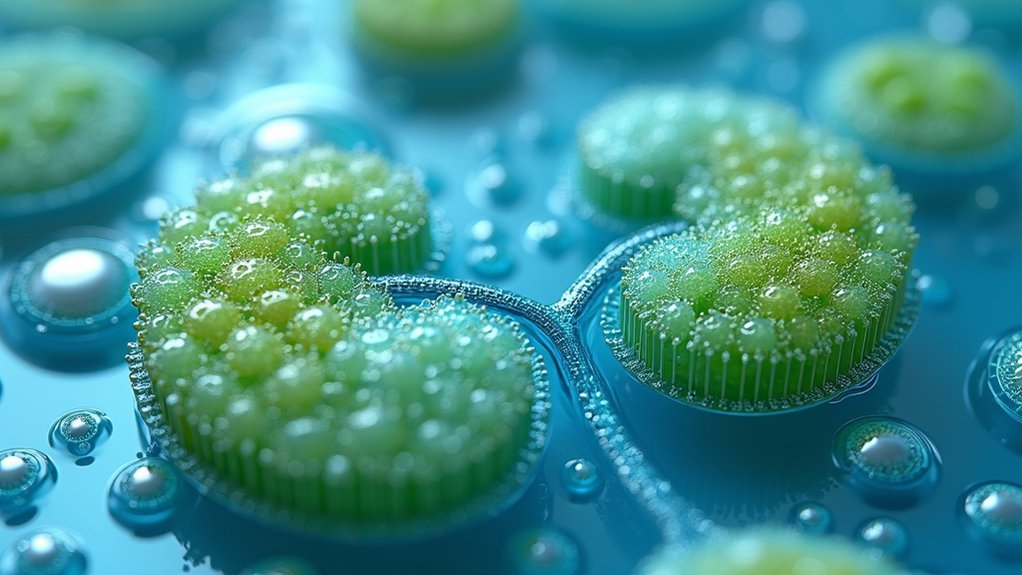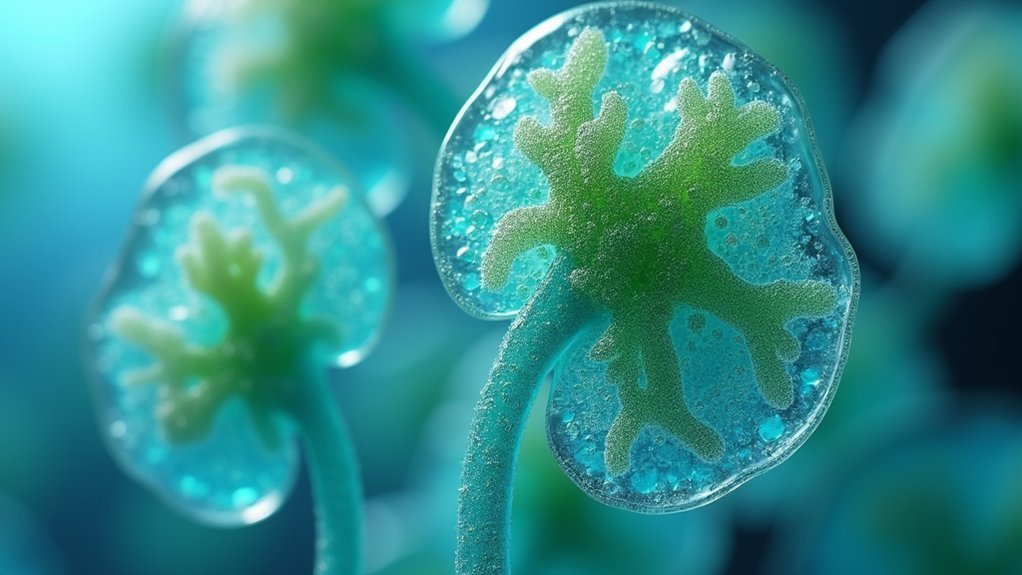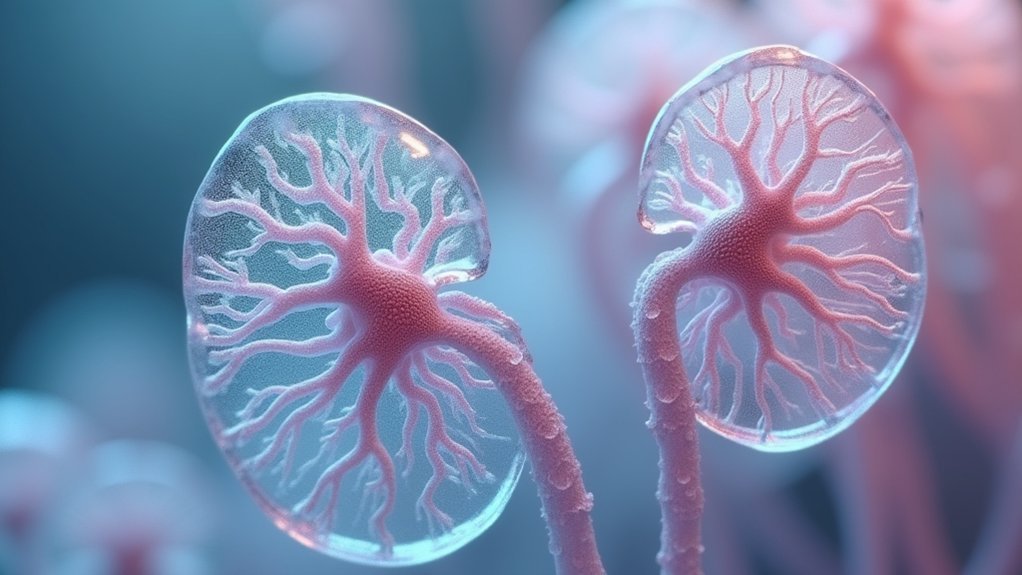You’ll find that advanced microfluidic bioprinting leads the breakthrough methods, using core-shell systems to reduce shear stress and enhance cell viability. Multi-material extrusion systems simultaneously deposit multiple bioinks for complex architectures, while hydrogel-based bioinks replicate native kidney matrix properties. Coaxial bioprinting creates vascular networks, and digital light processing achieves precise 50-micrometer resolution. Temperature-controlled systems, perfusion-enabled platforms, automated multi-nozzle setups, and hybrid construct techniques complete these revolutionary approaches that’ll transform your understanding of kidney regeneration possibilities.
Advanced Microfluidic Bioprinting for Enhanced Cell Viability

When you’re developing kidney organoids, advanced microfluidic bioprinting transforms cell survival rates through its sophisticated core-shell co-extrusion system.
Advanced microfluidic bioprinting’s core-shell co-extrusion system dramatically transforms kidney organoid development by maximizing cell survival rates through reduced shear stress.
You’ll experience dramatically reduced shear stress during the printing process, which directly enhances cell viability compared to traditional extrusion methods that often damage delicate cellular structures.
This technology enables you to precisely arrange different cell types and biomaterials, creating complex kidney organoids that closely replicate natural tissue architecture.
You can control growth factor and nutrient incorporation throughout the printing process, optimizing cellular proliferation and differentiation.
The microfluidic system provides you with a dynamic microenvironment that simulates physiological conditions, including proper fluid flow and nutrient exchange.
You’ll achieve superior organoid maturation while maintaining high-throughput production capabilities for generating functional nephrons efficiently.
Multi-Material Extrusion Systems for Complex Tissue Architecture
You’ll find multi-material extrusion systems revolutionize kidney organoid creation by depositing different bioinks simultaneously, enabling complex tissue architectures that closely mirror native kidney structure.
These systems let you integrate multiple cell types—renal epithelial cells, endothelial cells, and fibroblasts—while maintaining precise spatial control over their placement.
You can achieve the hierarchical organization essential for functional kidney tissue by leveraging advanced nozzle designs that position cells and materials exactly where they’re needed.
Simultaneous Multi-Bioink Deposition
As kidney organoid complexity demands increase, simultaneous multi-bioink deposition systems enable you to combine multiple bioinks in a single printing process, creating tissue architectures that closely replicate the kidney’s heterogeneous structure.
You’ll achieve precise spatial control over different cell types and biomaterials, essential for replicating the kidney’s intricate microenvironment necessary for nephron function.
This extrusion bioprinting approach lets you tailor mechanical and biochemical properties of printed constructs, enhancing cellular interactions and promoting tissue maturation.
You can greatly improve vascularization by incorporating endothelial cells within the printed matrix, addressing critical organoid development challenges.
These innovative techniques increase scalability and functionality for drug testing, disease modeling, and regenerative therapies.
Precise Spatial Cell Placement
While traditional single-material bioprinting limits your ability to replicate kidney complexity, multi-material extrusion systems revolutionize organoid construction by enabling precise spatial placement of distinct cell populations within a single printing process.
You’ll achieve unprecedented control over tissue architecture through precise deposition of multiple bioinks containing different cell types, matrices, and growth factors. This multi-material extrusion approach lets you create density gradients and heterogeneous environments that mirror native kidney structures.
| Feature | Benefit |
|---|---|
| Simultaneous bioink deposition | Enhanced cell-cell interactions |
| Controlled flow rates | Gradient formation capability |
| Reduced shear stress | Improved cell viability |
| Vascular integration | Better nutrient supply |
These systems dramatically improve cell viability by minimizing mechanical stress while facilitating complex vascular network incorporation essential for larger tissue constructs.
Hydrogel-Based Bioinks Mimicking Native Kidney Extracellular Matrix

Creating functional kidney organoids requires bioinks that closely replicate the complex extracellular matrix found in native kidney tissue.
You’ll find that hydrogel-based bioinks formulated from natural materials like gelatin, fibrin, and hyaluronic acid provide the ideal mechanical properties and biochemical cues necessary for kidney organoids success.
When you incorporate kidney-derived ECM components into your hydrogels, you’ll enhance organoid functionality and maturation by promoting nephron-like structures and improving cellular interactions.
You can achieve better vascularization and nephron formation by combining gelatin and fibrin in your bioink formulations, which greatly increases cell viability compared to traditional scaffolds.
The latest advances in stimuli-responsive and 3D-printable bioinks allow you to create more sophisticated kidney organoid models that better mimic in vivo kidney architecture and function.
Coaxial Bioprinting for Integrated Vascular Network Formation
Through coaxial bioprinting, you’ll simultaneously extrude two different bioinks to create core-shell structures that effectively replicate the hierarchical architecture of blood vessels in kidney organoids.
This technique enhances integration of endothelial cells and pericytes, promoting functional vascular network development that’s essential for nutrient and oxygen delivery in engineered kidney tissues.
You’ll achieve these key advantages with coaxial bioprinting:
- Precise spatial control – Direct cell arrangement to replicate complex native kidney microenvironments
- Improved organoid survival – Enhanced functionality through better vascularization supporting tissue viability
- Scalable production – Address current challenges in generating sufficient vascularized tissue for therapeutic applications
- Enhanced integration – Promote seamless connection between different cell types within the vascular network
This method demonstrates significant promise for regenerative medicine applications requiring complex tissue architecture.
Digital Light Processing for High-Resolution Nephron Structures

Digital Light Processing (DLP) bioprinting revolutionizes kidney organoid fabrication by achieving unprecedented resolution in nephron structure creation. You’ll harness light-cured photoresponsive bioinks to build complex geometries layer by layer, surpassing traditional extrusion methods’ limitations. With 50-micrometer resolution capabilities, you’re able to replicate kidney tissue microanatomy with exceptional precision.
| Feature | DLP Advantage |
|---|---|
| Resolution | 50 micrometers precision |
| Speed | High-throughput production |
| Geometry | Complex spatial arrangements |
| Cell Control | Precise positioning capability |
| Applications | Drug screening & personalized medicine |
You’ll benefit from rapid printing speeds that enable high-throughput bioprinted kidney organoid production for drug screening applications. By incorporating bioactive components and tailored hydrogels, your high-resolution nephron structures better recapitulate physiological kidney microenvironments, enhancing functional maturation for personalized medicine breakthroughs.
Spheroid-Based Bioprinting for Improved Cell Self-Organization
Spheroid-based bioprinting harnesses three-dimensional cell aggregates to dramatically enhance self-organization capabilities, delivering kidney organoids that mirror natural tissue architecture far more accurately than conventional flat cultures.
You’ll find that this approach creates physiologically relevant microenvironments where cells communicate and interact naturally, promoting superior differentiation and maturation.
This innovative spheroid-based bioprinting method offers several key advantages for kidney organoids development:
- Enhanced nephron progenitor generation – Creates better-organized structures that resemble actual human kidney developmental stages.
- Improved cell communication – Facilitates natural cell-to-cell interactions within three-dimensional aggregates for ideal cell self-organization.
- Diverse renal populations – Generates multiple kidney cell types from pluripotent stem cells within single organoids.
- Integrated vascular networks – Addresses critical maturation challenges by incorporating complex blood vessel formation.
Perfusion-Enabled Bioprinting Platforms for Functional Maturation
While traditional bioprinting methods struggle with nutrient delivery limitations, perfusion-enabled bioprinting platforms revolutionize kidney organoid development by incorporating sophisticated microfluidic systems that actively circulate media throughout the growing tissue.
You’ll find these systems effectively deliver oxygen and nutrients while removing waste products, mimicking natural kidney function.
When you integrate endothelial cells during the bioprinting process, you’re enabling vascular network formation that’s essential for long-term organoid survival.
This perfusion approach greatly enhances functional maturation compared to static cultures, with studies showing increased expression of renal-specific markers indicating proper differentiation.
You’ll achieve remarkably improved organoid viability and longevity, while the scalable nature of perfusion-enabled bioprinting makes it ideal for high-throughput drug screening and disease modeling applications.
Hybrid Cell-Laden Construct Assembly Techniques
By combining multiple cell types and biomaterials in strategic configurations, hybrid cell-laden construct assembly techniques enable you to create kidney organoids with unprecedented structural complexity and functional capacity.
You’ll achieve ideal results by integrating renal progenitor cells with endothelial cells and fibroblasts, promoting superior vascularization and tissue functionality. These hybrid constructs utilize advanced bioinks containing growth factors and extracellular matrix components that facilitate cellular interactions during development.
Key advantages of hybrid assembly techniques include:
- Dual printing methods – Combining extrusion-based bioprinting with droplet-on-demand approaches enhances cell density while minimizing shear stress.
- Enhanced viability – Strategic cell placement reduces mechanical damage during the printing process.
- Improved maturation – Supporting cell types accelerate kidney-specific structure development.
- Scalable architecture – Complex microenvironments replicate human kidney characteristics for drug testing applications.
Temperature-Controlled Bioprinting for Optimized Differentiation
Temperature-controlled bioprinting represents a vital advancement that allows you to precisely regulate cellular environments throughout the printing and maturation process. By maintaining temperatures around 37°C during printing, you’ll greatly boost nephron progenitor cell yields in your kidney organoids. This precise thermal control enhances cell self-organization, leading to improved structural integrity and functionality.
You’ll find that temperature-controlled bioprinting effectively mitigates thermal stress, which otherwise disrupts cell behavior and differentiation pathways. The technique promotes ideal cell viability and growth during printing, ensuring better outcomes for your organoid development.
When you implement these temperature control methods, you’ll observe noticeable increases in vascularization and maturation of kidney organoids. This enhanced development is essential for advancing therapeutic applications and achieving the functional complexity needed for successful regenerative medicine approaches.
Automated Multi-Nozzle Systems for Scalable Organoid Production
As bioprinting technology advances toward clinical applications, automated multi-nozzle systems emerge as the cornerstone for achieving scalable organoid production.
You’ll find these systems revolutionizing kidney organoid research by simultaneously depositing multiple bioinks, creating complex multi-cellular structures that mirror human kidney architecture.
These advanced systems offer remarkable capabilities for your research:
- High-throughput production – Generate hundreds of organoids in a single run, dramatically improving efficiency over traditional single-nozzle methods.
- Precise spatial control – Position different cell types and extracellular matrix components exactly where needed.
- Enhanced vascularization – Integrate nephron progenitors and endothelial cells to promote blood vessel formation.
- Standardized reproducibility – Enable consistent organoid production for drug screening and regenerative therapies.
You’ll achieve unprecedented scalability while maintaining the complex heterogeneous structure essential for functional kidney organoids.
Frequently Asked Questions
What Are the Estimated Costs for Establishing a Kidney Organoid Bioprinting Laboratory?
You’ll need $500,000-$2 million for establishing your kidney organoid bioprinting lab. You’re investing in specialized bioprinters, cell culture equipment, imaging systems, clean room facilities, and ongoing consumables that’ll sustain your research operations effectively.
How Long Does Regulatory Approval Typically Take for Bioprinted Kidney Organoids?
You’ll face 5-10 years for regulatory approval of bioprinted kidney organoids. FDA’s requiring extensive preclinical studies, safety data, and clinical trials before you can commercialize therapeutic applications in humans.
What Ethical Considerations Exist for Using Bioprinted Kidney Organoids in Research?
You’ll face consent issues when using human cells, must consider organoid sentience potential, need transparent research protocols, and should address equitable access to future treatments while ensuring you’re not exploiting vulnerable populations.
Can Bioprinted Kidney Organoids Be Transplanted Into Patients for Treatment?
You can’t transplant bioprinted kidney organoids into patients yet. Current organoids lack full kidney complexity, proper vascularization, and long-term functionality. They’re still experimental tools requiring significant development before clinical use.
What Are the Main Limitations Preventing Clinical Translation of Kidney Organoids?
You’ll face major hurdles including immature nephron development, lack of vascularization, immune rejection risks, inconsistent functionality, regulatory approval challenges, and scalability issues that currently prevent kidney organoids from reaching clinical transplantation applications.





Leave a Reply